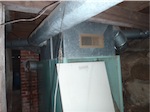Every year I get a slew of questions from people about all sorts of things in the gardening world. Some of them come from the numerous myths that run the gamut of gardening enthusiasts, to hearsay through the grapevine, to just general curiosity about day-to-day life in the garden. Some are very basic and some are a little more involved. There are even those that I have to research myself, as I have never encountered the subject matter or have never been faced with the dilemma in the garden myself. Since many of these questions are common among people, this week I thought I would share some of the most common along with some answers to inform those that may have the same questions.
One of the most common statements I hear from people is that they cannot grow anything under a spruce or pine tree because the ground is too acidic and it burns everything. This is a big myth. The fact is that evergreens have the majority of their root systems within the top 2 feet of soil. These roots are fibrous and dense, using up most of the soil’s moisture. Secondly, the tree’s canopy is also dense allowing very little light to penetrate through to assist in plant growth. Lastly, in our alkaline soils, it is nearly impossible to create an acid base so strong as to inhibit plant growth. If you want to try growing something under a spruce or pine tree canopy, try planting a shade and drought tolerant plant and see how they progress. (Lamium species are the perfect example.)
The most common question I have heard so far this year is, “How do I know when a melon is ripe in the garden?” Well, this is a more complicated question, as most melons ripen at a different rate and have different signs of maturity. Most articles you read will teach you about the “thump test” where you thump the rind to listen for that hollow thud or that solid sound. As easy as this may sound, everybody has a different sense of sound and what that means to them. One of the sure signs of maturity is the demise of the curly tendril at the base of the stem. This tendril is located right at the point where the stem of the melon joins the vine. When this tendril begins to shrivel and dry on a healthy vine, it is the main indicator that a melon is ripe. This mainly is true for watermelons, musk melon, cantaloupe and honeydew melon. Some other helpful signs of maturity are that the musk melon, honeydew melon and cantaloupe will emit a sweet scent from the rind when they are ripe. The watermelon develops a dull sheen to its rind indicating it is ripe. Honeydew melon rinds are often lightly hairy until maturity when the rind becomes smooth and shiny.
Often I hear people say things such as their chrysanthemums and iris are not hardy for the area, as they rarely come up the following season. There is fact to part of that statement if varieties are planted that are outside of our zone standards. However, if the varieties are said to be hardy for the area, the most likely culprit to them not returning the following year is that they are planted in a location that is too wet and their roots are rotting during the spring season. Try planting these hardy varieties in soils that are more sandy with better drainage and they will tend to come back reliably year after year.
Another common question I hear is, “When is the best time to divide perennials?” I always answer, “When you have the time!” But seriously, it is best to either divide in the spring or fall season. Perennials will indicate to you when it is time to divide in many ways. The most common is when they begin to die out in the center of the plant and only the edges seem healthy and vigorous. Another cue is when the plant no longer blooms much during the season. Dividing most perennials in the spring or fall will result in some blooms the following year and many again in the second season.
When is the best time to plant trees and shrubs? Usually planting them when they are dormant or going into dormancy is the best time. During the spring season, purchase bareroot stock that has not budded yet and plant it as soon as the ground thaws. These will take off quickly and grow without any transplant shock that you may get from container-grown stock. In the fall season, it is best to have evergreens planted by Sept. 15 so their roots can establish and absorb as much moisture as possible before the winter season. For deciduous trees, the rule of thumb is to plant them by Oct. 15 to ensure good root structure before the ground freezes up.
Of course, weather questions come up time and time again. “Will a late frost hurt my spring blooms?” Rarely will this occur as spring blooms close up at night and remain tight during the cold temperatures and the petals tend to be thicker than annuals. “What happens if the trees bud out in the spring and then we have a killing frost? Will my tree die?” The answer to that question is no. Trees and shrubs have secondary buds that will sprout in the event this should happen to prevent serious injury to the plant. If this happens repeatedly, this could cause stress on the tree and make them more susceptible to other problems, but a season that severe has yet to occur. One downfall to a late killing frost would be the demise of fruiting bodies if the tree or shrub happens to be in the flowering stage at the time.
Of course there is always the perennial question of “What kind of winter are we going to have?” Well, that answer to that is cold, windy and snowy! That is always a given in our area, yet subjective in many ways. The weather is a prediction in all cases with not much accuracy outside of 24 to 48 hours, so I tend to think of it as a crapshoot. However, there are plenty of stories about the pig’s spleen and its reliability of the winter’s severity. There is also the woolly caterpillar with the thick coat in fall that would indicate a cold winter or a thin coat that would indicate a warmer winter. I like to take a little reliability with the beaver’s activity along the river. Animals seem to have a keen sense of what is in the future when it comes to the weather. Last year the beavers were voracious in their appetite for food and began cutting down trees in August and continued until the first heavy snow. We ended up having a long and cold winter. Maybe they knew they needed an abundance of food to make it through a long winter. This year there is virtually no beaver activity along the river. I am thinking we will have a shorter, milder winter based on that observation. We will know for sure in about six months … so stay tuned!
- Home
- Blog
- Forum
- Green Home Topics

- »Healthy Home
- »Water Conservation
- »Energy Efficiency
- »Materials & Products
- »Resources
- Videos
- »From the Experts
- Remodeling with Passive House Approach
- How to Choose an Advanced Water Heater
- Choosing A Whole-House Ventilation System
- Selecting High Performance Windows
- Toward Zero Energy at Home - A Personal Example
- Remodel to Passive House Standards
- An Introduction to Ecological Landscaping
- Weingarten House at San Benancio - Energy
- A Deep Energy Retrofit Project
- Directory
- Events/News

- Shop
- About Us





